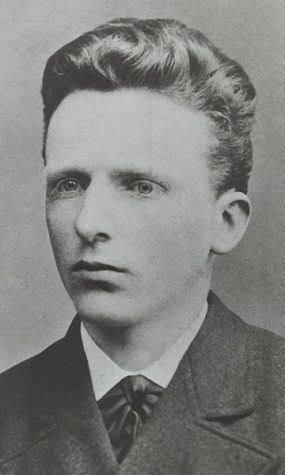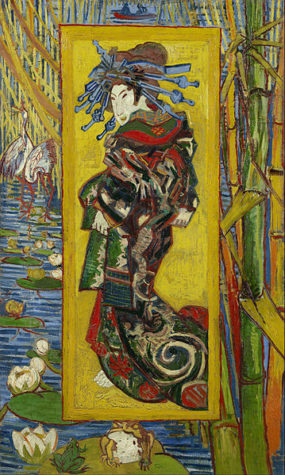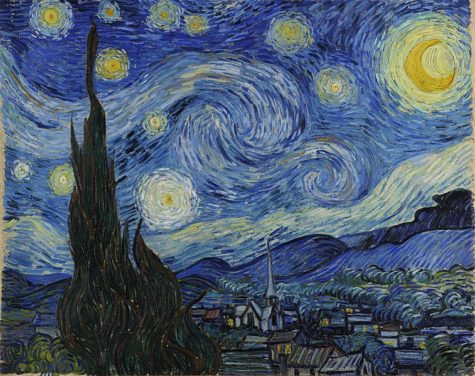A Look Into Vincent Van Gogh’s Life and Legacy
Despite his fame and recognition now, Van Gogh lived a life plagued by financial troubles and brief failed careers.

Jacobus Marinus Wilhelmus (J.M.W.) de Louw (1823-1907), Public domain, via Wikimedia Commons
Here is the only known photographic portrait of Vincentv Van Gogh at the age of 19.
Praised as one of the most influential artists in the world, Post-Impressionist painter Vincent van Gogh led a life that does not quite live up to the glory of his name now. With little formal art education, his artistic career spanned only 10 years, and he often struggled to financially support himself with his artwork.
Born Vincent Willem van Gogh on March 30th, 1853 in a small Brabant village of Zundert, Netherlands, the Dutch artist was the eldest of six children. His father, Theodorus van Gogh, a Protestant minister, and his mother, Anna Carbentus van Gogh, the daughter of a bookseller, named him after his deceased brother, who was stillborn exactly a year prior. The family frequently took long walks around Zundert, helping to introduce and cement a love for nature in the young van Gogh, which is reflected in various paintings of landscapes he would create decades later.
At 11, van Gogh transferred from his school in Zundert to a boarding school in Zevenbergen. Homesick, he sometimes drew, though without much sign of artistic talent. He finished his elementary schooling in Zevenbergen before enrolling in King Willem II secondary school in Tilburg, Netherlands, from which he left at the age of 15 for unknown reasons.

Van Gogh began apprenticing at The Hague branch of the art dealership Goupil & Cie at 16 years old, with the help of his uncle, who was a partner there. During his time at the firm, van Gogh began exchanging letters with his younger brother Theo, who worked for Goupil in Brussels. The brothers developed a life-long bond, with Theo emotionally and financially supporting his brother throughout his artistic career. From 1873 to 1876, van Gogh worked in London, and then in Paris, where the art firm dismissed him, as both he and the firm felt it was time to let him go.
In the years after his dismissal from Goupil, van Gogh took on various different jobs; he taught briefly at a private school in Isleworth, worked as a bookseller in Dordrecht, and became a lay preacher in the Borinage, a southwestern Belgian mining village. During this last stint as a preacher, he tried to immerse himself in the villagers’ poverty – he slept on the floor and gave away all of his middle-class possessions. Despite his attempts at connecting with the miners, his extremely literal interpretation of Christian teachings had little success in building a cohesive community of followers, and his sponsor did not renew his contract for more time in the Borinage.
In despair and suffering from a lack of purpose, van Gogh turned to art as his career. It was Theo who, after seeing the drawings and sketches sometimes included in his brother’s letters, suggested he start an artistic career. With this advice, van Gogh, at the age of 27, embarked on a journey that would lead him to create some of the most famed masterpieces of Post-Impressionism.
October 1880 marked the beginning of his artistic career, as van Gogh moved to Brussels in pursuit of honing his drawing technique. Believing that learning the fundamentals of art first was an essential before working in color, he concentrated on perfecting his skills with black and white and studied from anatomy, perspective, and composition books, like Charles Bargue’s Exercices au fusain and cours de dessin. He then worked in his parents’ home in Etten in The Netherlands in 1881; that year, he moved to the Hague to work with Anton Mauve, his cousin-in-law and a leading artist in the Hague School.
Mauve taught van Gogh about watercolor and oil painting, helping the novice artist broaden his artistic knowledge. Van Gogh also drew commissions of townscapes in The Hague for his uncle, who was also an art dealer.
During a brief stay in Nuenen, a village in the Brabant, in 1883-1885, he focused on depicting farmers, weavers, and rural life. Drawing inspiration from artists like Rembrandt and Jean-François Millet, van Gogh painted The Potato Eaters, which captures a bucolic family meal in an agrarian setting, using the dark hues prevalent in his early works.
In another brief period of formal art education, van Gogh moved to Belgium to study at the Antwerp Academy in 1886. He stayed there for three months before leaving the academy to live in Paris with Theo and take lessons taught by Fernand Cormon. Van Gogh attended these classes in Cormon’s studio, learning alongside other artists, like Henri de Toulouse-Lautrec, Émile Bernard, and Paul Gauguin.
In Paris, Theo introduced his brother to the works of Impressionist painters Claude Monet and Pierre-Auguste Renoirand, as well asNeo-Impressionists Paul Signac and Georges Seurat.
This exposure to modern French artists helped Van Gogh develop his signature style as it is known today. Using the short coarse brushstrokes of Impressionists and the colorful palette of the Neo-Impressionists, he experimented with painting different subjects with new techniques. The pointillist brushwork (an art technique that sculpts form and shape through varying concentration of dots) in Self-Portrait with Grey Felt Hat and Self-Portrait with a Straw Hat (just two of over 20 self-portraits he created in Paris), for example, accompany bright and expressive color palettes.

The Dutch artist also discovered a newfound admiration for Japanese woodcut prints; he, along with Theo, began collecting them. Van Gogh incorporated hints of the definite outlines and color harmonies in these woodcuts in his own work.
After spending two years in Paris, he left the bustling city in 1888 and journeyed to Arles, a small town in the south of France. There, he drew inspiration from daily life, painting orchards, harvests, and boats.
Van Gogh planned to create a studio in Arles for a group of artists to sell their work through Theo in Paris. As a first step, in October 1888, Paul Gauguin moved in with van Gogh, allowing the two artists to work together. However, Gauguin mostly painted from his imagination, while van Gogh painted what he tangibly saw; their different beliefs caused frequent arguments. In a letter to Theo in December 1888, van Gogh wrote: “Gauguin and I talk a lot about Delacroix, Rembrandt &c. The discussion is excessively electric. We sometimes emerge from it with tired minds, like an electric battery after its run down.”
When tensions eventually escalated too high, van Gogh threatened Gauguin with a razor. Van Gogh’s mental health deteriorated, and he sliced off part of his own ear, wrapped it in newspaper, and gave it to a local maid. Van Gogh was admitted to a hospital, staying until January 1889.

He continued to paint, though he admitted himself to Saint-Paul-de-Mausole psychiatric hospital in Saint-Rémy in May 1889, as he feared another uncontrolled bout of mental instability. There, he experimented with his style, creating some of his most well known pieces, including Starry Night and Cypresses, from his residence. He painted what he saw both inside and outside the asylum, with the aforementioned pieces being just a few of his 40 different paintings of cypress trees. His fascination with these trees had grown from when he first saw them in Arles to the mental hospital in Saint-Rémy. The Metropolitan Museum of Art in New York is currently holding the first exhibit that solely concentrates on the artist’s depictions of these trees; the Van Gogh’s Cypresses gallery is on view from May 22nd to August 27th, 2023.
Evidently, van Gogh created numerous paintings and drawings at his time in the psychiatric hospital, making many of his best-known works. His artistic productivity at the hospital, however, was coupled with his worsening mental health: in one instance, he ate his oil paint.
A few months prior to van Gogh’s commitment to the mental hospital, in April 1889, Theo had married Johanna (‘Jo’) Bonger in Amsterdam. After receiving news in January 1890 of the couple’s newborn son, who was named Vincent Willem van Gogh, Van Gogh painted Almond Blossom from his room in the hospital.
Van Gogh eventually left the mental hospital in May 1890, this time for Auvers-sur-Oise. Near Theo in Paris and looked after by Dr. Paul Gachet (who was also an amateur painter), van Gogh effectively created a painting a day. In early July 1890, however, he became extremely worried about his financial future, as Theo, who had been supporting him, was planning on leaving his art dealing job to start a business. This may have been too great a burden for the artist; his financial woes are largely believed to be a primary reason for his premature death.
Van Gogh shot himself in the stomach on July 2th, 1890 and died two days later in his room at the Auberge Ravoux. He had left behind a legacy that was just beginning to form.
Throughout van Gogh’s career, Theo had been submitting his brother’s work to the annual ‘Salon des Indépendants’ exhibition in Paris, so there had been some recognition for the artist. After both brothers’ deaths, Van Gogh’s work gained even more acclaim: Theo’s wife Jo brought more attention to his art through exhibition loans to museums worldwide and publishing the brothers’ letters.
Over 850 paintings and almost 1,300 drawings stand as a testimony to van Gogh’s craft, as his innovative Post-Impressionist style became renowned for its novelty in vibrant colors, definitive brushstrokes, and an expressiveness that words may never truly capture.
In a letter to Theo in December 1888, van Gogh wrote: “Gauguin and I talk a lot about Delacroix, Rembrandt &c. The discussion is excessively electric. We sometimes emerge from it with tired minds, like an electric battery after it’s run down.”
Katherine Han is a Copy Chief for ‘The Science Survey.’ She enjoys how journalistic writing serves as a channel of knowledge and medium for experimentation...










